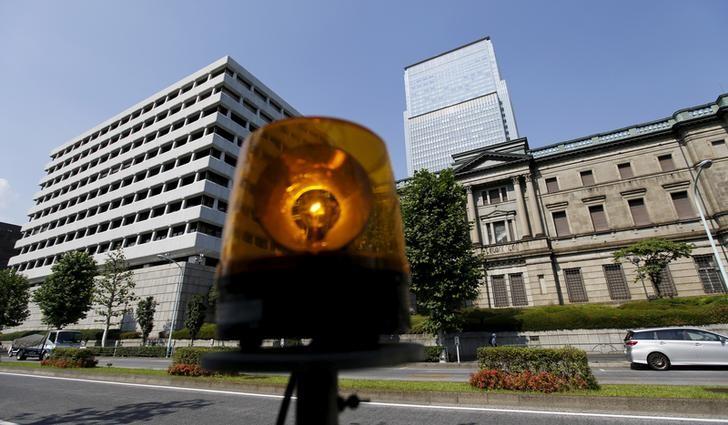BOJ may rattle global bond markets as Fed seen on hold

NEW YORK/SINGAPORE - The Bank of Japan may steal the thunder from the US Federal Reserve and its chair Janet Yellen this week if it chooses to give more monetary stimulus in its latest effort to jumpstart its economy and the US central bank decides to stand pat on interest rates.
If the BOJ, led by Governor Haruhiko Kuroda, decides to shake up its policy stance, one avenue would be to be less aggressive in purchasing longer-dated assets, thereby allowing yields to go up, while cutting short-term rates deeper into negative territory.
This would likely result in a rise in yields of US Treasuries and other government bonds, and on the margin push uplong-term borrowing costs for consumers and corporations.
Japanese investors have poured money into foreign bonds in a scramble for income-generating assets as domestic bond yield shave turned negative. This is contributing to holding global yields near historically low levels.
"The BOJ is important in part because the Japanese have been buying anything abroad that gives them yields," said David Keeble, global head of interest rates strategy at Credit Agricole Corporate & Investment Bank in New York.
Last week, the yield on 10-year Japanese government debt rose close to zero percent, a level not seen since March, in aglobal bond market sell-off triggered by the European Central Bank's decision to refrain from expanding its asset purchase program on Sept. 8.
The ECB's move intensified worries that major central banks are running out of tools to aid their economies.
"Japan has struck a chord in terms of the generalised perception that there isn't that much left in that tank for policymakers from a monetary standpoint," said Charlie Diebel, head of rates at London-based asset manager Aviva Investors.
"Therefore, if you still need to provide stimulus, perhaps monetary policy isn't the way it is going to be forthcoming,"
The US economy is far from robust, posting a sub-par 1.2percent increase in second quarter gross domestic product. However, Japan, the world's third-biggest economy, is struggling even more, eking out just 0.7 percent growth in the same period.
The BOJ will undertake a comprehensive review of its monetary policy at its Sept. 20-21 meeting, and there is speculation it may lower short-term interest rates deeper into negative territory and change its bond purchasing program.
Fed Chair Yellen and other US policy-makers, who will convene during the same period as their Japanese counterparts, are widely expected to leave their benchmark policy rate unchanged in a range of 0.25-0.50 percent. They will likely keep the door open for a rate increase by year-end.
To be sure, if the Fed stuns investors by raising rates within hours of their Japanese counterparts' decision, that would overshadow anything coming from Tokyo.
The consensus is the Fed will keep its powder dry given the recent patch of soft economic data. Also, it may be reluctant to raise rates, and possibly upset financial markets, ahead of a tightening presidential election on Nov. 8.
ONE FOOT OUT THE DOOR
Japan's struggle has persisted even as the BOJ adopted unconventional measures of negative interest rates and massive asset purchases aimed at spurring consumption and investments, while also helping exports with a weaker yen.
Instead the yen has risen 15 percent against the dollarJPY= and 13 percent versus the euro EURJPY= so far this year. Bond curves globally have meanwhile steepened, led by a rise in Japanese long-term yields, in the past couple of weeks.
"If you think about the last 15-20 years, we always thought Japan was the outlier. In fact, it turned out they were pretty much the leader," said Ashley Perrott, head of Asian fixed income at UBS Asset Management in Singapore.
"The rest of the world has followed the Japan path to lower yields. And I think they are still probably leading," he said.
The BOJ's ability to communicate its intent is therefore key, and some analysts even suspect the confusion heading into Wednesday's meeting is intentional, aimed at upsetting the single-bet mentality in the market and thus limit any fallout.
Interest rate markets implied traders expect a 17 percent chance the BOJ would lower its target rate to -0.30 percent onWednesday and a 14 percent chance the Fed would raise the federal funds rate by a quarter point, according to Reuters data. BOJWATCH FEDWATCH
Real money and leveraged investors are therefore playing it extremely safe. Perrott, whose team manages $3 billion in its Asian portfolios, has cut back on interest rate exposure, while still holding derivatives that will protect UBS should bond markets rally once again.
"It is a wild card and will definitely see markets move," Scott Mather, chief investment officer of US Core Strategies and a managing director at the $1.5 trillion Pacific Investment Management Co (PIMCO), referring to the BOJ.
"We are relatively neutral on the government-bond market and we don’t have a large position to our risk exposure in Japan. Definitely, investors are coming up to the sense that the effect of monetary stimulus is not as advertised.” -Reuters







